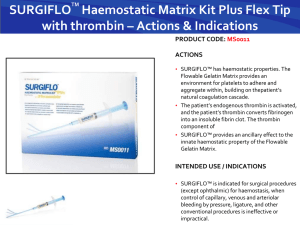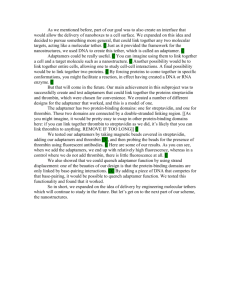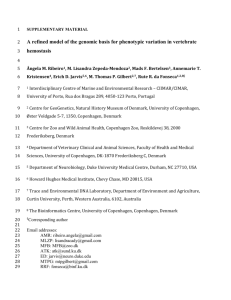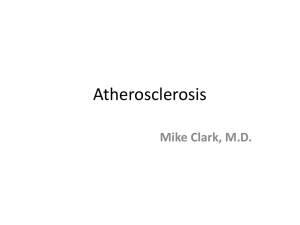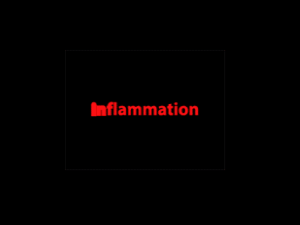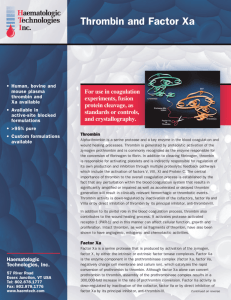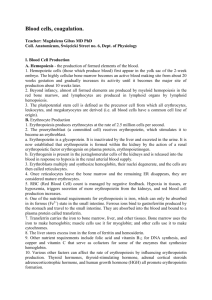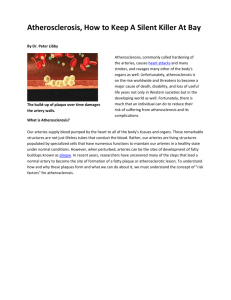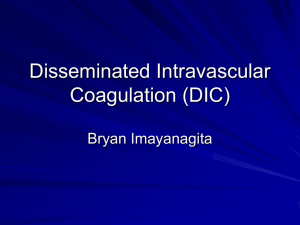The Hemostatic System as a Modulator of Atherosclerosis
advertisement
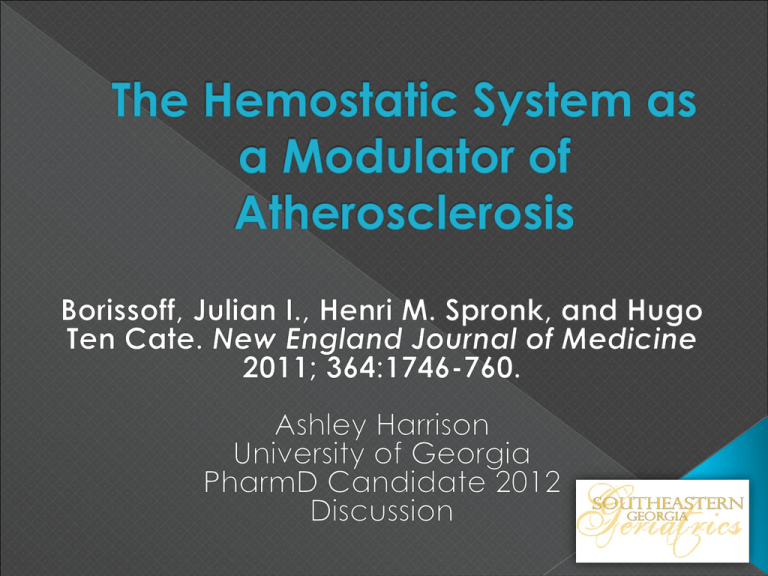
Classically, the onset and progression of atherosclerosis is related to inflammation Macrophages, neutrophils, and lymphocytes play a pivotal role in destabilizing and rupturing atherosclerotic plaques, resulting in atherothrombosis However, there has been recent linkage of the inflammation and coagulation in atherosclerosis While antiplatelet/anticoagulant therapy has not been shown to produce regression of plaques, the hemostatic modulators influence the composition of the arterial wall. Hemostasis: slowed blood flow › Due to… Normal vasoconstriction Abnormal obstruction (plaques) Coagulation/surgical means (ligation) The goal is to achieve an equilibrium that allows for proper blood flow and to stop bleeding after vascular injury. When this balance is disrupted, it can lead to thrombus formation or bleeding Aside from their traditional hemostatic role, platelets are also important in pro-inflammatory conditions such as atherosclerosis Coagulation proteins are involved in disrupting the endothelial barrier, leukocyte recruitment, inflammation, migration and proliferation of VSMCs, and angiogenesis Most of these actions are mediated by the TFFVIIa complex, factor Xa, and thrombin and involve protease-activated receptors (PARs). PARs are located on vascular cells normally. However, in atherogenesis these receptors are overexpressed When inflammation is present, the vascular endothelium changes to a proatherogenic phenotype (regardless of vascular wall injury) As a result, cell-adhesion molecules such as Pselectin are enhanced on the surface of both platelets and endothelial cells. The upregulation of P-selectin causes platelets to interact with circulating leukocytes, which is critical in plaque formation and progression At the same time, platelets adhere to the endothelium primarily via vWF, causing them to secrete atherogenic mediators: cytokines, chemokines, adhesion molecules, coagulation factors, etc. Intact endothelium has an anticoagulant phenotype Circulating platelets and clotting factors do not significantly adhere Vascular injury exposes subendothelial matrix proteins (collage, von Willebrand factor) and changes to a procoagulant phenotype Matrix proteins cause platelet adherence and activation and subsequent secretion of… › ADP: induces platelet aggregation › TXA2: plt. activator and vasoconstrictor › 5-HT: vasoconstrictor and plt. aggregation This results in platelets binding to fibrinogen and cross-linking to other platelets– “platelet plug” Coagulation proteins have been linked to atherogenesis by increased thrombin-generating activity in early atherosclerotic lesions The increased presence of these coagulation factors in early atherosclerotic vessels will eventually contribute plaque instability Also, clinical studies have shown that a more fibrous plaque structure (rather than a lipid-rich structure with inflammatory cells) is associated with thrombin generation in coronary artery stenosis patients Tissue factor is considered to be the primary starting point of the coagulation pathway TF is found to be higher in atherosclerotic lesions from patients with unstable angina or MI vs. those with stable conditions Factor VII forms a complex with TF, which takes part in: vascular remodeling, angiogenesis, chemotaxis, and inflammation. Plasma levels of TF antigen are associated with markers of subclinical atherosclerosis (increased carotid intima-media thickness) and increased risk of CV-related death While this pathway is not essential in hemostasis, it may be involved in arterial thrombosis Negatively charged surfaces in blood trigger the cleavage of factor XII, which activates proinflammatory kallikrein-kinin and complement. Factor XII-mediated formation of bradykinin regulates vasodilation and vascular permeabilities as well as induces complement activation. Levels of kallikrein in tissue and prekallikrein in plasma have been associated with CVD severity If factor XII and the kallikrein-kinin system are stimulated over a period of time, this may encourage a proatherogenic environment The intrinsic and extrinsic pathways both activate factor X to Xa Factor Xa signals various cell types of the CV system– this contributes to the production of proinflammatory cytokines, celladhesion molecule expression, and up-regulation of TF These signals may contribute to the progression of atherosclerotic plaques by causing inflammation, migration of leukocytes, and angiogenesis An important pharmacologic finding is that factor Xa inhibitors reduced vascular remodeling and neointimal formation Under normal circumstances, thrombin binds to thrombomodulin to enhance the activation of protein C, an endogenous anticoagulant and antiinflammatory. During atherogenesis, thrombomodulin decays allowing thrombin to potentiate endothelial dysfunction, oxidative stress, inflammation, and activation of platelets and leukocytes. Thrombin (along with factors Xa, XIa, IXa, and plasmin) also cleaves complement proteins C3 and C5 which induce inflammation and chemotaxis of inflammatory cells. Furthermore, Melagatran (a direct thrombin inhibitor) reduces progression of atherosclerosis and promotes plaque stability by inhibiting proinflammatory transcription factors › This effect shows a cross-linking between coagulation and inflammation in atherosclerosis Plasma fibrinogen levels are a major indicator of the amount of formed thrombin. › In the presence of thrombin, fibrinogen is converted to fibrin, forming a fibrin clot The effects of fibrinogen on the plaque phenotype… › Favors permeability of endothelial cells, accumulation of LDL, and formation of foam cells › Induces monocyte and VSMC migration › Increases platelet reactivity and aggregation › Enhances inflammation Factor XIII is also known as “fibrin stabilizing factor” because it cross-links fibrin to form fibrin chains, creating an insoluble clot Factor XIII also enhances the formation of angiotensin II receptors, worsening atherosclerosis by continually sensitizing circulating monocytes and enhacing inflammation. Tissue Factor Pathway Inhibitor (TFPI) acts on factor VIIa and Xa to decrease thrombin formation, resulting in decreased angioenesis, vascular remodeling, inflammation, and increased clearance of lipoproteins TFPI co-localizes with TF, regulating its effects within atherosclerotic lesions TFPI also inhibits matrix metalloproteinases which play a pivotal role in destabilizing plaques Studies have shown that TFPI-deficient mice have significantly more plaques than control mice and that overexpression of TFPI is associated with lower cholesterol levels and reduced plaque development Thrombin, despite its many procoagulant effects, also acts as an anticoagulant. It activates protein C by binding to protein C receptors. Protein C then dissociates and forms a complex with protein S leading to inactivation of factors Va and VIIIa, therefore down-regulating additional generation of thrombin Studies have indicated that atherosclerotic vessels have decreased protein C receptor expression, leading to decreased anticoagulant activity/regulation of thrombin There is an intimate cross-linkage between hemostasis and inflammation in atherosclerosis While anticoagulant therapy is important in prevention of thrombosis, it has not yet demonstrated regression of plaque growth However, while long-term warfarin administration has not shown any visible effect on plaque progression, patients who under went CABG showed a 35% reduction in mortality 3 years after discontinuation. This evidence leads to the possibility of warfarin therapy to alter plaque phenotypes With traditonal vascular imaging using ultrasound, it has been difficult to accurately examine phenotypes and changes of plaques due to poor tissue penetration. The use of high-resolution MRI in assessing plaque characteristics will support the phenotyping of vasculature walls as a method of determining the role of hemostasis in atherosclerosis Currently, very few medications target relevant molecules of hemostasis. With this potential, new research and therapeutic options should be investigated › Oral direct inhibitors of Xa and thrombin › Small molecules that can access vessel walls and potentially alter plaques DX-9065A Pradaxa Borissoff, Julian I., Henri M. Spronk, and Hugo Ten Cate. New England Journal of Medicine 2011; 364:1746-760. Dipiro, Joseph T., Terry L. Schwinghammer, and Cecily V. Dipiro. “Venous Thromboembolism.” Pharmacotherapy Handbook. By Barbara G. Wells. 7th ed. New York: McGraw-Hill Companies, 2009. 163-65. Katzung, Bertram G., Susan B. Masters, and Anthony J. Trevor. "Drugs Used in Disorders of Coagulation." Basic and Clinical Pharmacology. 11th ed. New York: McGraw-Hill Companies, 2009. 587-91
